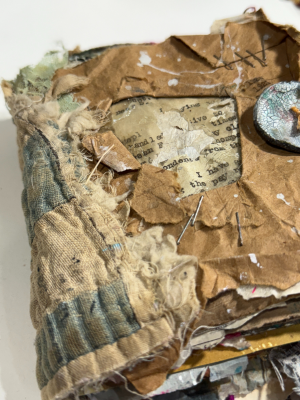Why Cardboard.....
Using cardboard as your artistic playground can be a game-changer, especially if you're looking for a stress-free approach to making art. It's all about letting go, embracing imperfections, and just playing with what you have. There's no pressure to create a masterpiece, just an invitation to explore and enjoy the process.
I recently circled back to a video I made on my Youtube Channel about four years ago, and it instantly reminded me why I so love to recycle no matter what art form I'm using. Think about it: cardboard is everywhere, it's sturdy, and best of all, it's free. This immediately takes away a huge chunk of the pressure. No expensive canvases to worry about "ruining" and no need to overthink your next move. Here's why cardboard is perfect for a relaxed art session:
Zero Cost, Zero Pressure: Since you're not spending money, the stakes are incredibly low. This freedom allows you to experiment boldly without the fear of wasting materials. Splatter paint, cut it up, tear it – it's just cardboard!
Abundant Supply: Cereal boxes, shipping boxes, even paper towel rolls can be flattened and used. You'll likely never run out, which means endless opportunities to practice and play.
Versatile Surface: Cardboard takes to almost any medium. Acrylics, tempera, markers, collage, even watercolors (if you prime it first) work beautifully. Its natural texture can also add an interesting element to your work.
Embrace Imperfection: Cardboard often has creases, folds, or printed designs. Instead of seeing these as flaws, view them as unique starting points or built-in textures that add character to your art.
Play, Don't Produce
The real magic happens when you shift your mindset from "making art" to "playing with materials."
Start with No Goal: Instead of having a finished product in mind, just pick up a piece of cardboard and a tool. Make some marks, add some color, cut a shape. See where it takes you.
Experiment Freely: Try out those techniques you've been hesitant about on your "good" paper. Use a palette knife to apply thick paint, rip pieces and glue them down for a collage, or even poke holes and stitch through the cardboard.
Focus on the Process: Enjoy the tactile sensation of the cardboard, the way the paint glides or the marker scratches. This is your time to unwind and be present with your creative flow, not to judge the outcome.
It's All Good: If a piece doesn't turn out how you expected, it's not a failure; it's a learning experience, or simply a fun mess. You can paint over it, cut it up and use it in another piece, or just toss it back into the recycling bin with a smile.
So next time you're feeling the creative itch but are overwhelmed by the thought of starting, grab some cardboard. Let go of expectations, embrace the "trash," and just allow yourself to play. You might be surprised by the joy—and the art—that emerges.
What kind of recycled materials are you curious about incorporating into your art next?

